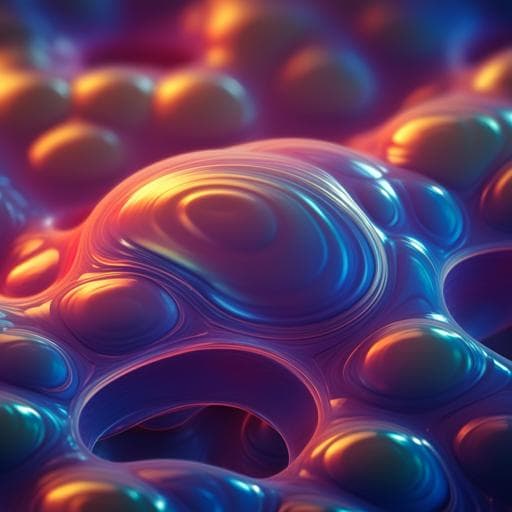
Engineering and Technology
Spontaneous formation of a self-healing carbon nanoskin at the liquid-liquid interface
E. Bomal, P. Grandgeorge, et al.
Discover the groundbreaking research on a self-healing carbon nanoskin that forms at the oil-water interface. This innovative material combines impressive stiffness and self-healing properties, with potential applications ranging from synthetic cells to industrial catalysis. This exciting work was conducted by Enzo Bomal, Paul Grandgeorge, Reuben J. Yeo, Nicolas Candau, Pedro M. Reis, and Holger Frauenrath.
~3 min • Beginner • English
Introduction
The study addresses how to create mechanically robust yet dynamic and self-healing interfacial membranes, inspired by biological membranes that can self-repair, reshape, and remain impermeable. Conventional liquid interfaces stabilized by molecular surfactants typically lack solid-like mechanical resilience, while colloid/polymer assemblies can jam to form more robust interfaces. The authors aim to demonstrate a single-component, spontaneous route to an ultrathin, stiff, and self-healing carbon membrane formed at a liquid–liquid (oil–water) interface. The purpose is to reconcile high stiffness with self-healing and reshaping capability in a nanometrically thin interfacial layer, enabling stabilization of complex, out-of-equilibrium droplet shapes and advancing applications in templating, compartmentalization, and additive manufacturing.
Literature Review
Prior work shows that biological membranes can sustain mechanical loads yet dynamically reshape and self-repair. Synthetic analogs using surfactants and colloids can mimic some features, including stimulus responsiveness and interfacial jamming to stabilize complex shapes. Structured liquids have been created via colloid–polymer co-assembly at interfaces, and 2D carbon nanomaterials (e.g., graphene oxide) have been assembled at liquid interfaces, yielding mechanically robust and conductive interfaces with barrier properties that reduce evaporation. Interface-assisted synthesis of 2D materials has advanced, but combining high stiffness with self-healing and reconfigurability remains challenging. Earlier hexayne amphiphiles enabled room-temperature formation of functional carbon nanosheets, motivating exploration of reactive surfactants that could carbonize directly at liquid interfaces to form solid skins.
Methodology
- System and materials: A reactive hexayne phosphonic acid surfactant (octacosa-5,7,9,11,13,15-hexayne phosphonic acid, denoted 1) dissolved in chloroform (0.001–0.05 mmol/L) against Millipore water to form a chloroform/water interface at ambient conditions.
- Interfacial tension and adsorption: Pendant-drop tensiometry (Kruss DSA30) measured equilibrium interfacial tension γ over 180 s. At low c ≤ 0.01 mmol/L, γ ≈ 27 mN/m; sharp decrease at c = 0.02 mmol/L; plateau near γ ≈ 5 mN/m for c ≥ 0.05 mmol/L indicated saturation and solid skin formation. Dynamic evolution at constant volume tracked diffusion-limited adsorption and subsequent solidification.
- Pressure–volume (P–V) analysis: A pendant drop underwent an inflation–hold–deflation cycle while synchronously recording pressure (Honeywell SMT RR sensor), drop shape, volume, and surface area. Models used: (i) Young–Laplace fit (shape fitting) for fluid interfaces; (ii) isosurfactant model assuming conserved interfacial surfactant count, with adapted surface tension γ_is; (iii) isoperimetric model assuming inextensible solid behavior along meridians (anisotropic surface stress) yielding P_ip = A1 − Δρ g H. The liquid-to-solid conversion X = (P − P_ip)/(P_is − P_ip) versus relative area change (1 − A/A0) defined the onset of solidification. The critical area Ac was obtained from the tangent at maximum slope intersecting X = 0. Initial interfacial tension γ0 and concentration Γ0 were related by a simplified Gibbs isotherm Γ0 = (γ − γ0)/K with K ≈ 1.19 (±0.04) × 10^6 mN·m·mol^−1.
- Diffusion coefficient: Determined for surfactant 1 via 2D DOSY NMR (Bruker Avance III 400 MHz) in CDCl3/CD3OD (4:1) to parameterize diffusion-controlled adsorption.
- Structural characterization: Nanoskins transferred to substrates via Langmuir–Blodgett or Langmuir–Schaefer. UV–vis–NIR (JASCO V-670) assessed absorption. Raman spectroscopy (inVia confocal Raman, 532 and 785 nm excitation) identified poly(ene-yne) and carbon D/G bands. IR reflection–absorption spectroscopy (Bruker Vertex 80v/Hyperion 3000) probed C≡C features. UV irradiation (250 W Ga-doped low-pressure Hg lamp, 30 cm distance, 1 h) accelerated carbonization.
- Morphology and thickness: SEM (Zeiss Gemini SEM300) and TEM (Thermo Scientific TALOS F200X, 200 kV) imaged transferred films on 2000 mesh Cu grids. AFM (Asylum Research Cypher S, tapping mode) measured topography and thickness via histogram deconvolution. Spectroscopic ellipsometry (Semilab SE2000) using a three-layer optical model (Si/SiO2/nanoskin, n = 1.45 for nanoskin) provided thickness across assembly times.
- Mechanical characterization:
- Wrinkling elastometry: At a flat chloroform/water interface (c = 0.05 mmol/L), an aluminum blade compressed the interface after different assembly times t. Wrinkle wavelengths λ were extracted from images (Nikon D850). Using thickness h = 3.8 nm (ellipsometry), the bending modulus E was estimated from E = 12(π^2/λ^4) ρ g (elasto-gravitational scaling) after calibration per refs. The evolution of E with t was obtained.
- Tensile testing: A calibrated cantilever beam contacted the flat interface. Translation at v = 20 ± 2 mm/min increased tension until membrane rupture. Maximum force F_max converted to tensile strength (mN/m) by dividing by contact length l; stress at rupture estimated by dividing by effective thickness.
- Interfacial shear rheology: Double-wall ring (DWR) geometry on a TA Instruments Discovery HR-3 measured 2D storage (G′) and loss (G″) moduli during formation (time sweep at 1 rad/s, γ = 0.1%). Self-healing protocol: rupture via strain ramp 0.1–100% in 1 min, rest (1–10 min), then recovery at γ = 0.1%, repeated with increasing healing times.
- Reshaping/self-healing demonstrations: High-resolution imaging captured droplet coalescence resistance, forced fusion to create channels and tubules, and trapping of gas bubbles. Movies and synchronized pressure were recorded with a Basler ace camera and custom LabVIEW synchronization.
- Controls: Regular surfactant and another hexayne surfactant with different head-group size showed no wrinkling/solidification under similar conditions, underscoring the role of molecular packing at the interface.
Key Findings
- Spontaneous solid skin formation: Reactive hexayne surfactant 1 self-assembles at the chloroform/water interface and, upon surpassing a critical interfacial concentration, rapidly carbonizes to form an elastic, solid nanoskin within seconds to minutes.
- Interfacial mechanics and triggering: The normalized critical area Ac/A0 increases linearly with Γ0 and reaches 1 at the critical interfacial concentration Γc ≈ 4.2 ± 0.3 molecules/nm^2. Interfacial tension decreases from ~27 mN/m toward ~21 mN/m at Γc (diffusion-limited adsorption), then drops sharply and converges to γw ≈ 5 mN/m indicating full coverage by an incompressible nanoskin. Visible wrinkling onset approaches A/A0 ≈ 1 as γ0 → γw.
- Structure and carbonization pathway: Spectroscopy shows rapid formation of cross-linked poly(ene-yne) domains (broad UV–vis band ~768 nm; Raman C=C and C≡C bands at 1100–1450 and ~2103 cm^−1) followed by slower graphitization (Raman D/G bands at ~1338–1365 and ~1525–1537 cm^−1). IR RA band at 2198 cm^−1 (C≡C) disappears upon full carbonization (UV-accelerated or aging). Final material is a 2D amorphous carbon monolayer with sp2 clusters and 10–20% sp3 content.
- Geometric packing rationale: Γc corresponds to a mean molecular area ~24 Å^2, matching dense packing of phosphonate headgroups and the average size (24–30 Å^2) of C12 “carbon tiles,” explaining the low activation barrier and mechanical triggering; similar hexaynes with mismatched head groups do not carbonize under same conditions.
- Morphology and thickness: Continuous, self-supporting films spanning many micrometers observed by SEM/TEM with wrinkling at edges. Thickness by ellipsometry: 3.8 ± 1.2 nm (stable over time); AFM: 5.2 ± 1.5 nm at t = 3 min increasing to ~8.7 ± 2.8 nm at t = 30 min (transfer-related effects).
- Mechanical properties:
- Bending modulus E from wrinkle wavelengths: ~40 GPa shortly after solidification; increases with assembly time to as high as ~600 GPa.
- Tensile strength: Tangential force at rupture ~15 mN/m; corresponding rupture stress ~0.4 MPa; behavior is brittle, attributed to anisotropy, heterogeneity, and defects.
- Interfacial shear rheology: Early elastic behavior (tan δ ≈ 0.1). G″ plateaus near 0.085 N/m after ~2 min and then decreases; G′ increases to ~0.75 N/m for c = 0.05 mmol/L (t > 15 min). At lower c = 0.02 mmol/L, tan δ ≈ 0.6 with G′ ≈ 0.011 N/m and G″ ≈ 0.0066 N/m.
- Self-healing and reshaping: After rupture by large strain, the nanoskin recovers up to ~85% of its original modulus after 15 min (c = 0.05 mmol/L). At lower concentration (c = 0.02 mmol/L), repeated rupture/heal cycles can increase G′ up to ~120% of its initial value, consistent with continued crosslinking at domain boundaries. Nanoskin enables reversible droplet reshaping: resists spontaneous coalescence, fuses under compression to form channels/tubules, supports irregular suspended droplets with narrow necks, and traps gas bubbles.
Discussion
The work demonstrates that a single-component, reactive surfactant can spontaneously form a solid carbon monolayer at a liquid–liquid interface, reconciling high stiffness with dynamic, self-healing behavior. Pressure–volume analyses show a clear transition from fluid-like to solid-like interfacial mechanics at a critical interfacial concentration Γc, also reflected in the interfacial tension evolution. Spectroscopy reveals a two-stage pathway: rapid 2D polymerization into poly(ene-yne) networks followed by graphitization into amorphous sp2-rich carbon domains. The geometric match between the head-group packing and the size of emergent carbon tiles rationalizes the low activation barrier and mechanochemical triggering during deflation. Mechanically, the nanoskin attains bending moduli comparable to 2D carbon materials while remaining brittle in tension due to anisotropy and defects. The discrepancy between bending-derived modulus and interfacial shear moduli is consistent with anisotropic monolayer mechanics and liquid-like substituent layers. Crucially, residual reactivity enables self-healing, restoring functionality after rupture and allowing for reversible reshaping of droplets, including complex morphologies (tubes, channels, suspended necks). These findings validate the concept of a stiff yet reconfigurable interfacial carbon membrane, advancing the design of robust, dynamic interfaces for templating and compartmentalization.
Conclusion
A mechanically robust, ultrathin carbon nanoskin can spontaneously form at an oil–water interface from a single reactive hexayne surfactant. Once a critical interfacial concentration is reached, rapid solidification and subsequent carbonization yield a continuous, few-nanometer-thick amorphous carbon monolayer decorated by substituents. The nanoskin exhibits high bending stiffness (initially ~40 GPa, rising to ~600 GPa with time), interfacial elasticity in shear, and self-healing that enables reversible reshaping and stabilization of complex droplet geometries. These unprecedented combinations of properties for a carbon nanomaterial open avenues for liquid-in-liquid 3D printing, microstructured composite manufacturing, mechanically stabilized synthetic cells, and rigid yet dynamic catalytic compartments. Future research could explore tuning head-group chemistry and packing to control triggering thresholds and mechanical properties, broadening solvent and oil systems, quantifying permeability/barrier functions, minimizing defects to reduce brittleness, and integrating stimuli-responsiveness for programmable reshaping.
Limitations
- Brittleness and defect sensitivity: Despite high bending stiffness, the nanoskin exhibits brittle failure in tension (rupture stress ~0.4 MPa), likely due to anisotropy, heterogeneity, and defects.
- Anisotropic mechanics: Disparity between bending and shear moduli indicates complex, anisotropic behavior that complicates translation to bulk-like property metrics.
- Kinetics and completeness of carbonization: Full carbonization without UV can take weeks; accelerated UV treatment alters structure, which may affect properties and application conditions.
- Specificity of molecular design: Robust formation depends on a precise head-group size/packing; similar hexayne surfactants without matching geometry did not carbonize, limiting generality without molecular optimization.
- Environmental and system scope: Demonstrations are in a chloroform/water system at ambient conditions; performance and stability across different solvent pairs, temperatures, and chemical environments were not comprehensively assessed.
- Thickness measurement variability: AFM thickness appears to increase with assembly time due to transfer artifacts; in situ thickness control and uniformity may require improved methodologies.
Related Publications
Explore these studies to deepen your understanding of the subject.







